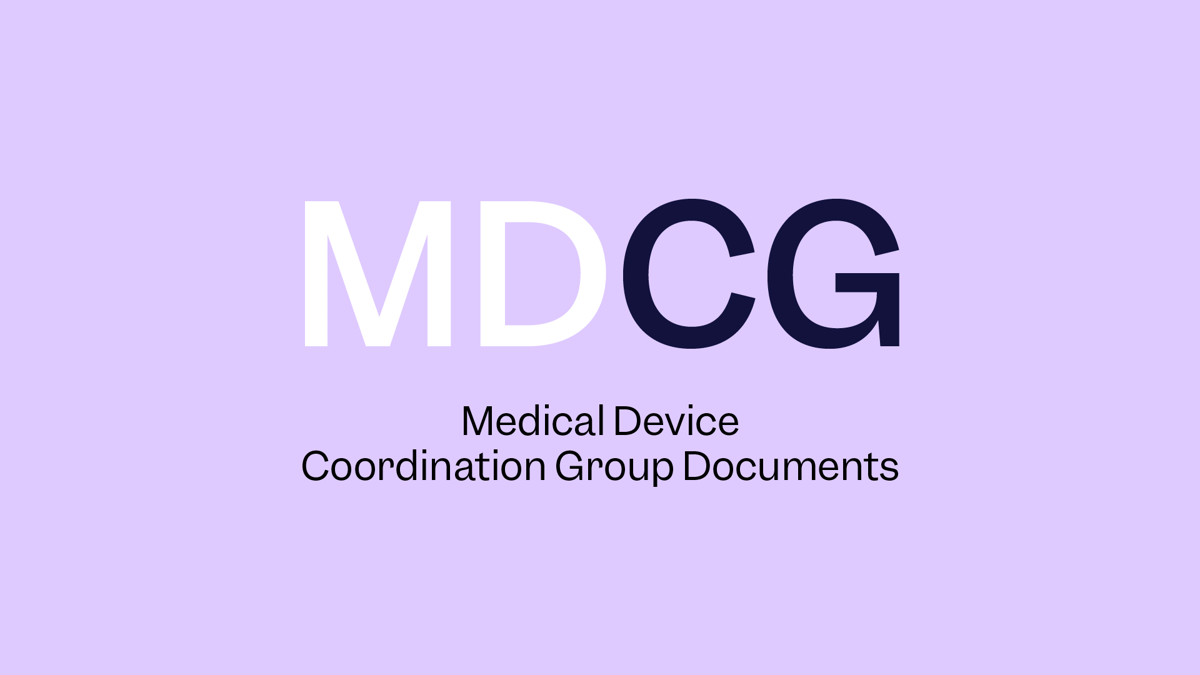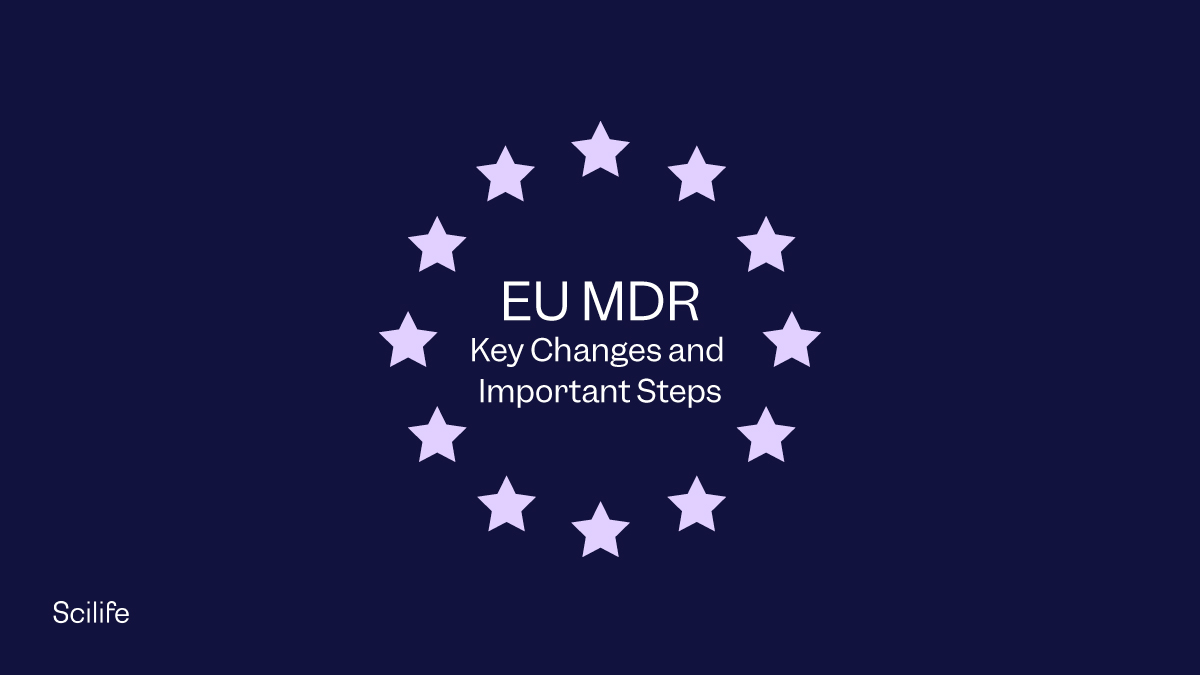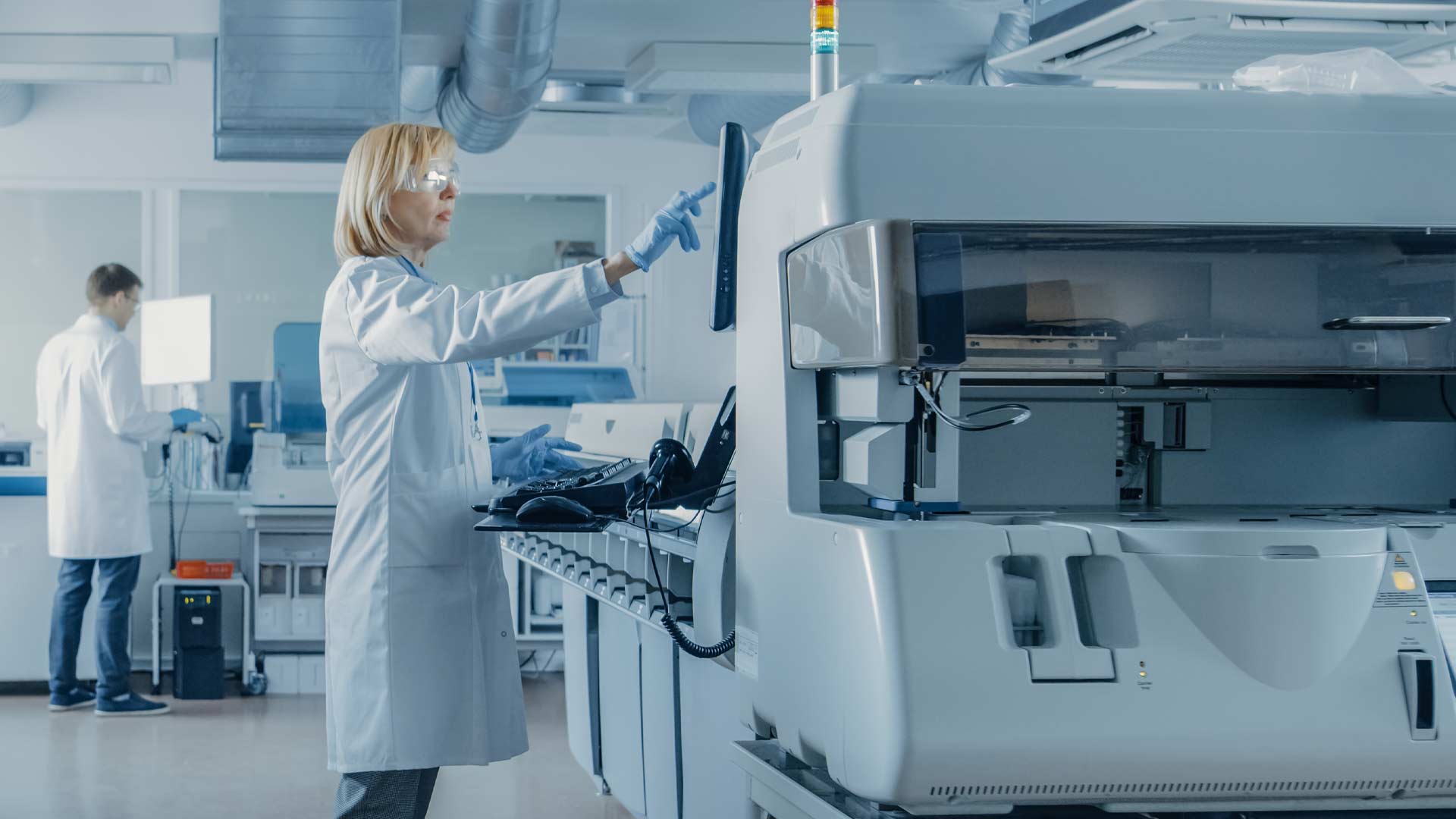
How much do you know about Medical Device Coordination Group Documents?
You may be more familiar with their abbreviation: MDCG.
Developed on behalf of the European Commission, MDCG Documents are designed to help manufacturers understand how the Medical Device Regulation (MDR) and In Vitro Diagnostics Regulation (IVDR) should be applied to medical devices with an effective and harmonized implementation of European legislation. In addition, the guidance documents are a useful source for device manufacturers, notified bodies, and other authorities.
MDCG Documents play a key role in the life sciences space, where conformity assessment is vital. This article will discuss what exactly these documents are and why they are so important. Continue reading for a full breakdown.
What Are MDCG Documents?
In the life sciences, MDCG Documents outline common approaches that manufacturers and notified bodies ought to follow in their conformity assessment procedures (specifically to meet MDR 2017/745 requirements).
These documents are written by the MDCG, composed of authorities in the European public health space. More specifically, MDCG consists of stakeholders appointed by member states based on their role and expertise in medical devices. The group aims to advise the EU Commission and contribute to the consistent implementation of medical devices.
It is important to note that the MDCG documents are simply guidelines—they are not legally binding. However, most stakeholders still expect manufacturers to follow them. The goal is to ensure the consistent, uniform application of directive provisions when developing medical devices.
MEDDEV documents were used under the MDD. Now, they are being superseded by MDCG guidance documents under the MDR and IVDR, which is a part of the transition from MDD to the new MDR.
32 MDCG documents were published in 2021, and 27 new MDCG documents have been published in 2022 at the time of this writing. More MDCG documents are increasingly being applied for. Topics like the Unique Device Identifier and the EUDAMED database are new for manufacturers and are only addressed by the MDCG guides.
What Do MDCG Documents Cover?
MDCG Documents feature specific reference codes. In addition, documents are drafted and denominated by the following format: “MDCG Year-Number-revision.”
The documents are endorsed at the Medical Device Coordination Group’s plenary meetings and cover a range of topics, including:
- Borderline and Classification
- Class I devices
- Clinical investigation and evaluation
- COVID-19
- Custom devices
- EUDAMED database
- European medical device nomenclature
- Implant cards
- Importers and Distributors
- In vitro diagnostic medical devices
- New technologies
- Notified bodies
- Standards
- Unique Device Identifier
- Other topics
- Other guidance documents
Below, you’ll find an extensive list of the main MDCG Documents split by topics. Skip it here, and go to the next section “What Stakeholders work with MDCG Documents”.
|
Topic |
Reference |
Title |
Publication |
|---|---|---|---|
|
Borderline and Classification |
MDCG 2022-5 |
Guidance on borderline between medical devices and medicinal products under Regulation (EU) 2017/745 on medical devices |
April 2022 |
|
MDCG 2021-24 |
Guidance on classification of medical devices |
October 2021 |
|
|
Class I Devices |
MDCG 2020-2 Rev.1 |
Class I transitional provisions under Article 120 (3 and 4) – (MDR) |
March 2020 |
|
MDCG 2019-15 Rev.1 |
Guidance notes for manufacturers of class I medical devices |
December 2019 |
|
|
Clinical investigation and evaluation |
MDCG 2021-28 |
Substantial modification of clinical investigation under Medical Device Regulation |
December 2021 |
|
MDCG 2021-20 |
Instructions for generating CIV-ID for MDR Clinical Investigations |
July 2021 |
|
|
MDCG 2021-8 |
Clinical investigation application/notification documents |
May 2021 |
|
|
MDCG 2021-6 |
Regulation (EU) 2017/745 – Questions & Answers regarding clinical investigation |
April 2021 |
|
|
MDCG 2020-13 |
Clinical evaluation assessment report template |
July 2020 |
|
|
MDCG 2020-10/2 MDCG 2020-10/1 |
Guidance on safety reporting in clinical investigations Appendix: Clinical investigation summary safety report form |
May 2020 |
|
|
MDCG 2020-8 |
Guidance on PMCF evaluation report template |
April 2020 |
|
|
MDCG 2020-7 |
Guidance on PMCF plan template |
April 2020 |
|
|
MDCG 2020-6 |
Guidance on sufficient clinical evidence for legacy devices |
April 2020 |
|
|
MDCG 2020-5 |
Guidance on clinical evaluation – Equivalence |
April 2020 |
|
|
MDCG 2019-9 Rev.1 |
Summary of safety and clinical performance |
March 2022 |
|
|
COVID-19 |
MDCG 2022-1 |
Notice to 3rd country manufacturers of SARS-CoV-2 in vitro diagnostic medical devices |
January 2022 |
|
MDCG 2022-21 Rev.1 |
Guidance on performance evaluation of SARS-CoV-2 in vitro diagnostic medical devices |
August 2021 |
|
|
MDCG 2021-7 |
Notice to manufacturers and authorized representatives on the impact of genetic variants on SARS-COV-2 in vitro diagnostic medical devices |
May 2021 |
|
|
MDCG 2021-2 |
Guidance on state of the art of COVID-19 rapid antibody tests |
March 2021 |
|
|
COVID-19 TESTS: Q&A on in vitro diagnostic medical device conformity assessment and performance in the context of COVID-19 |
February 2021 |
||
|
Conformity assessment procedures for protective equipment |
July 2020 |
||
|
How to verify that medical devices and personal protective equipment can be lawfully placed on the EU market and thus purchased and used – also in the COVID-19 context |
May 2020 |
||
|
Guidance on regulatory requirements for medical face masks |
June 2020 |
||
|
Guidance on medical devices, active implantable medical devices and in vitro diagnostic medical devices in the COVID-19 context |
April 2020 |
||
|
Conformity assessment procedures for 3D printing and 3D printed products to be used in a medical context for COVID-19 |
April 2020 |
||
|
MDCG 2020-9 |
Regulatory requirements for ventilators and related accessories |
April 2020 |
|
|
Custom-Made Devices |
MDCG 2021-3 |
Questions and Answers on Custom-Made Devices |
March 2021 |
|
EUDAMED |
MDCG 2021-13 Rev.1 |
Questions and answers on obligations and related rules for the registration in EUDAMED of actors other than manufacturers, authorized representatives and importers subject to the obligations of Article 31 MDR and Article 28 IVDR |
July 2021 |
|
MDCG 2021-1 Rev.1 |
Guidance on harmonized administrative practices and alternative technical solutions until EUDAMED is fully functional |
May 2021 |
|
|
MDCG 2020-15 |
MDCG Position Paper on the use of the EUDAMED actor registration module and of the Single Registration Number (SRN) in the Member States |
August 2020 |
|
|
MDCG 2019-5 |
Registration of legacy devices in EUDAMED |
April 2019 |
|
|
MDCG 2019-4 |
Timelines for registration of device data elements in EUDAMED |
April 2019 |
|
|
European Medical Device Nomenclature (EMDN) |
MDCG 2021-12 |
FAQ on the European Medical Device Nomenclature (EMDN) |
June 2021 |
|
The EMDN – The nomenclature of use in EUDAMED |
January 2020 |
||
|
The CND nomenclature – Background and general principles |
January 2020 |
||
|
MDCG 2018-2 |
Future EU medical device nomenclature - Description of requirements |
March 2018 |
|
|
Implant cards |
MDCG 2021-11 |
Guidance on Implant Card – Device types |
May 2021 |
|
MDCG 2019-8 v2 |
Guidance document implant card on the application of Article 18 Regulation (EU) 2017/745 on medical devices |
March 2020 |
|
|
Importers & Distributors |
MDCG 2021-27 |
Questions and Answers on Articles 13 & 14 of Regulation (EU) 2017/745 and Regulation (EU) 2017/746 |
December 2021 |
|
MDCG 2021-26 |
Q&A on repackaging & relabeling activities under Article 16 of Regulation (EU) 2017/745 and Regulation (EU) 2017/746 |
October 2021 |
|
|
In Vitro Diagnostic medical devices (IVD) |
MDCG 2022-10 |
Q&A on the interface between Regulation (EU) 536/2014 on clinical trials for medicinal products for human use (CTR) and Regulation (EU) 2017/746 on in vitro diagnostic medical devices (IVDR) |
May 2022 |
|
MDCG 2022-9 |
Summary of safety and performance template |
May 2022 |
|
|
MDCG 2022-8 |
Regulation (EU) 2017/746 - application of IVDR requirements to ‘legacy devices’ and to devices placed on the market prior to 26 May 2022 in accordance with Directive 98/79/EC |
May 2022 |
|
|
MDCG 2022-6 |
Guidance on significant changes regarding the transitional provision under Article 110(3) of the IVDR |
May 2022 |
|
|
MDCG 2022-3 |
Verification of manufactured class D IVDs by notified bodies |
February 2022 |
|
|
MDCG 2022-2 |
Guidance on general principles of clinical evidence for In Vitro Diagnostic medical devices (IVDs) |
January 2022 |
|
|
MDCG 2021-22 |
Clarification on “first certification for that type of device” and corresponding procedures to be followed by notified bodies, in context of the consultation of the expert panel referred to in Article 48(6) of Regulation (EU) 2017/746 |
August 2021 |
|
|
MDCG 2021-4 |
Application of transitional provisions for certification of class D in vitro diagnostic medical devices according to Regulation (EU) 2017/746 |
April 2021 |
|
|
MDCG 2020-16 Rev.1 |
Guidance on Classification Rules for in vitro Diagnostic Medical Devices under Regulation (EU) 2017/746 |
January 2022 |
|
|
New technologies |
Infographic |
Is your software a Medical Device? |
March 2021 |
|
MDCG 2020-1 |
Guidance on clinical evaluation(MDR) /Performance evaluation(IVDR) of medical device software |
March 2020 |
|
|
MDCG 2019-16 Rev.1 |
Guidance on cybersecurity for medical devices |
December 2019 |
|
|
MDCG 2019-11 |
Qualification and classification of software- Regulation (EU) 2017/745 and Regulation (EU) 2017/746 |
October 2019 |
|
|
Notified bodies |
MDCG 2022-4 |
Guidance on appropriate surveillance regarding the transitional provisions under Article 120 of the MDR with regard to devices covered by certificates according to the MDD or the AIMDD |
February 2022 |
|
MDCG 2019-6 Rev.3 |
Questions and answers: Requirements relating to notified bodies |
October 2021 |
|
|
MDCG 2021-23 |
Guidance for notified bodies, distributors and importers on certification activities in accordance with Article 16(4) of Regulation (EU) 2017/745 and Regulation (EU) 2017/746 |
August 2021 |
|
|
MDCG 2021-18 |
Applied-for scope of designation and notification of a conformity assessment body– Regulation (EU) 2017/746 (IVDR) |
July 2021 |
|
|
MDCG 2021-17 |
Applied-for scope of designation and notification of a conformity assessment body– Regulation (EU) 2017/745 (MDR) |
July 2021 |
|
|
MDCG 2021-16 |
Application form to be submitted by a conformity assessment body when applying for designation as notified body under the in vitro diagnostic devices regulation (IVDR) |
July 2021 |
|
|
MDCG 2021-15 |
Application form to be submitted by a conformity assessment body when applying for designation as notified body under the medical devices regulation (MDR) |
July 2021 |
|
|
MDCG 2021-14 |
Explanatory note on IVDR codes |
July 2021 |
|
|
MDCG 2020-17 |
Questions and Answers related to MDCG 2020-4: |
December 2020 |
|
|
“Guidance on temporary extraordinary measures related to medical device notified body audits during COVID-19 quarantine orders and travel restrictions” |
|||
|
MDCG 2020-14 |
Guidance for notified bodies on the use of MDSAP audit reports in the context of surveillance audits carried out under the Medical Devices Regulation (MDR)/In Vitro Diagnostic medical devices Regulation (IVDR) |
August 2020 |
|
|
MDCG 2020-12 |
Guidance on transitional provisions for consultations of authorities on devices incorporating a substance which may be considered a medicinal product and which has action ancillary to that of the device, as well as on devices manufactured using TSE susceptible animal tissues |
June 2020 |
|
|
MDCG 2020-11 |
Guidance on the renewal of designation and monitoring of notified bodies under Directives 90/385/EEC and 93/42/EEC to be performed in accordance with Commission Implementing Regulation (EU) 2020/666 amending Commission Implementing Regulation (EU) 920/2013 |
May 2020 |
|
|
MDCG 2020-4 |
Guidance on temporary extraordinary measures related to medical device notified body audits during COVID-19 quarantine orders and travel restrictions |
April 2020 |
|
|
MDCG 2020-3 |
Guidance on significant changes regarding the transitional provision under Article 120 of the MDR with regard to devices covered by certificates according to MDD or AIMDD |
March 2020 |
|
|
MDCG 2019-14 |
Explanatory note on MDR codes |
December 2019 |
|
|
MDCG 2019-13 |
Guidance on sampling of devices for the assessment of the technical documentation |
December 2019 |
|
|
MDCG 2019-12 |
Designating authority's final assessment form: Key information (EN) |
October 2019 |
|
|
MDCG 2019-10 Rev.1 |
Application of transitional provisions concerning validity of certificates issued in accordance with the directives |
October 2019 |
|
|
MDCG 2018-8 |
Guidance on content of the certificates, voluntary certificate transfers |
November 2018 |
|
|
Standards |
MDCG 2021-5 |
Guidance on standardization for medical devices |
April 2021 |
|
Unique Device Identifier (UDI) |
MDCG 2022-7 |
Q&A on the Unique Device Identification system under Regulation (EU) 2017/745 and Regulation (EU) |
May.22 |
|
MDCG 2021-19 |
Guidance note integration of the UDI within an organization’s quality management system |
July 2021 |
|
|
MDCG 2021-10 |
The status of Appendixes E-I of IMDRF N48 under the EU regulatory framework for medical devices |
June 2021 |
|
|
MDCG 2021-09 |
MDCG Position Paper on the Implementation of UDI requirements for contact lenses, spectacle frames, spectacle lenses & ready readers |
May.21 |
|
|
MDCG 2018-1 Rev. 4 |
Guidance on basic UDI-DI and changes to UDI-DI |
April 2021 |
|
|
MDCG 2020-18 |
MDCG Position Paper on UDI assignment for Spectacle lenses & Ready readers |
December 2020 |
|
|
MDCG 2019-2 |
Guidance on application of UDI rules to device-part of products referred to in article 1(8), 1(9) and 1(10) of Regulation 745/2017 |
February 2019 |
|
|
MDCG 2019-1 |
MDCG guiding principles for issuing entities rules on basic UDI-DI |
January 2019 |
|
|
MDCG 2018-7 |
Provisional considerations regarding language issues associated with the UDI database |
October 2018 |
|
|
MDCG 2018-6 |
Clarifications of UDI related responsibilities in relation to article 16 |
October 2018 |
|
|
MDCG 2018-5 |
UDI assignment to medical device software |
October 2018 |
|
|
MDCG 2018-4 |
Definitions/descriptions and formats of the UDI core elements for systems or procedure packs |
October 2018 |
|
|
MDCG 2018-3 Rev.1 |
Guidance on UDI for systems and procedure packs |
June 2020 |
|
|
Other topics |
MDCG 2021-25 |
Application of MDR requirements to "legacy devices" and to devices placed on the market prior to 26 May 2021 in accordance with Directives 90/385/EEC or 93/42/EEC |
October 2021 |
|
MDCG 2019-7 |
Guidance on article 15 of the medical device regulation (MDR) and in vitro diagnostic device regulation (IVDR) on a ‘person responsible for regulatory compliance’ (PRRC) |
June 2019 |
|
|
MDCG 2019-3 rev.1 |
Clinical evaluation consultation procedure exemptions Interpretation of article 54(2)b |
April 2020 |
The MDCG Documents go into quite a bit of detail. It’s best to look at each section—and the corresponding reference codes—individually in order to optimize your familiarity with the concepts and your conformity assessment procedures.
What Stakeholders Work with MDCG Documents?
A variety of stakeholders contributed to drafting the MDCG Documents. They are chosen for their professional experience and competency in the medical device industry. The entire committee has about 60 members. Key parties in the development of these documents include:
- European Commission
- Notified bodies
- Standardization bodies
- European member state authorities
Why Are MDCG Documents Important?
The reason why MDCG Documents are so important is simple: conformity assessment. The documents ensure each medical device meets a certain standard—by verifying that the standard in question is applied in all aspects of manufacturing.
The idea of conformity assessment is to create consistent, replicable results. This offers benefits such as:
- Consumer confidence
- Competitive edge
- Regulator peace of mind
As the MDCG Documents show, conformity assessment incorporates a range of techniques, including testing, inspection, validation, and verification. These activities may result in different standards of conformity.
Why Does Conformity Assessment Matter?
Conformity assessment determines whether the device manufacturing process meets the requirements described in a given standard or specification. In the case of the MDCG Documents, this standard is composed of the documents themselves. In short, this is why conformity assessment is crucial:
- Governments can verify the safety of a medical device and better protect constituents from unnecessary risk.
- Insurers can rest assured that manufacturers have mitigated risks and addressed safety concerns in their devices.
- Investors can enjoy an added layer of security.
- Consumers can gain proof of the device’s safety, reliability, and performance.
This benefits consumers, regulators, suppliers, and the manufacturers. It allows manufacturers to prove their device meets the relevant safety and performance standards while giving other parties confidence in the marketplace. Surely, not all medical devices undergo the most stringent conformity assessment procedures. But MDCG Documents offer a reasonable conformity assessment framework so that all manufacturers can at the very least ensure a certain degree of replicability.
Key Considerations
While beneficial, it is important to note that the MDCG Documents have drawn extensive criticism from time to time. This is mostly because the process behind the scenes is rather opaque. Some claim the guidance documents lack patient representation, while others believe the definition of legal liability is too vague—with some notified bodies evaluating manufacturers based on the MDCG Documents beyond the scope of the pertinent directives.
While the MDCG Documents support manufacturers by specifying regulatory requirements, many stand firm in their belief that there needs to be more clarity.
Although medical devices play a key role in the regulatory landscape in the European Union, the process is not seamless for life sciences companies. However, addressing—and preventing—nonconformity is key in healthcare.
In this way, MDCG Documents can help manufacturers navigate all factors involved in bringing high-quality, researched-backed products to market. And MDCG Documents do, in fact, increase companies’ regulatory efforts. From risk-benefit analysis to data accessibility, manufacturers must pay attention to all facets of the MDCG Documents when developing their medical devices.
Next Steps
Do you have questions about the MDCG Documents? Is your Life Sciences organization searching for more insight into quality control, replicability, governance, and conformity assessment?
Discover how Scilife Smart QMS can help you stay fully compliant with MDR and IVDR!





